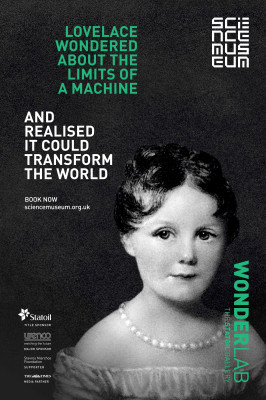The Science Museum’s Head of Communications, Peter Dickinson, responds to concerns raised about an image used in the marketing campaign for our new interactive gallery.
Wonderlab: The Statoil Gallery is extraordinary; it is a gallery designed with the sophistication to impress one of the UK’s most respected architecture critics, the Observer’s Rowan Moore, while at the same time prompting Time Out to write: “If Stephen Hawking and Willy Wonka designed the ultimate science playground then it might go a little like this. The Science Museum’s new ‘Wonderlab’ gallery is the best thing you can currently do in London with kids.”
You can see here the excitement of the competition winners who became the first to experience the gallery. We’d invited those young people to ‘wonder the world better’ as part of a broader launch campaign about redefining wonder. We wanted to inspire young people to believe that their ‘wonders’ could change the world and they, and many others, have been sharing their wonders with us in the lead up to Wonderlab’s opening.
As this film, voiced by Sir David Attenborough, beautifully illustrates, our goal is to encourage girls and boys, men and women to be inspired by the wonder of science, and help more people believe that science is for them. We want people to think differently about the world around them and to recognise that wondering is a powerful, positive tool in the journey to scientific discovery. This idea infuses every aspect of our communications campaign – on which we worked with an excellent creative team at Grey London – from the posters we used prior to opening to those currently on show in the underground.
Our historical posters, which included the wonders of Ada Lovelace and Alan Turing, sought to demonstrate their amazing achievements which started with a wonder. We’ve now released two posters designed specifically to relate to content in the gallery – Flowing Mist, an exhibit where you literally ‘put your head in the clouds’, and our Heat Camera. Our intention is to excite the public about the new exhibits on display, whilst using a simple visual metaphor to help inspire the next generation of scientists by showing them that wondering is powerful.
These posters invite people to think again about phrases in common usage – ‘seeing what you’re made of’ or ‘having your head in the clouds’. The goal of our campaign – and these posters – is to challenge the idea of ‘wondering’ being whimsical, and encourage and inspire young people to wonder, to pay close attention to what’s around them, to be curious and to be creative. Some people have suggested that featuring a girl in the ‘head in the clouds’ poster reinforces a negative stereotype. All we can say is that this is the polar opposite of our intention with this campaign. Indeed, we specifically chose to feature a girl in another of the campaign posters with the headline ‘one day someone will cure cancer’ because we know that women are under-represented in STEM careers and this is a reality we all want to change.
At the Science Museum, we are passionate about igniting curiosity among everyone and believe we have an important role to play in inspiring more women and girls to become involved in science. Half of our visitors last year – 1.6 million – were women and girls. Research shows that informal learning experiences, such as those enjoyed by Science Museum visitors in interactive galleries since 1931, really do help more people to feel that science is for them.
‘As part of a family holiday when I was 7 years old (coming to London from Sheffield seemed a long way then) we made a special trip to the Science Museum. Just exploring science for fun was something I had not experienced before. I am sure that set the grounds for a life that just cannot be without science.’ – Dr Helen Sharman, Science Museum Fellow and first Briton in space.
‘I have very happy memories as a young child being enthralled by the interactive gallery in the Science Museum. The power of pressing buttons and seeing the exhibits come to life was really exciting – and I remember running from one to the next. Of course things are much more sophisticated now with Wonderlab providing interactive experiences beyond anything we imagined.’ – Professor Dame Ann Dowling OM DBE FREng FRS, President of the Royal Academy of Engineering
We truly believe Wonderlab will help us to inspire the scientists of tomorrow.


